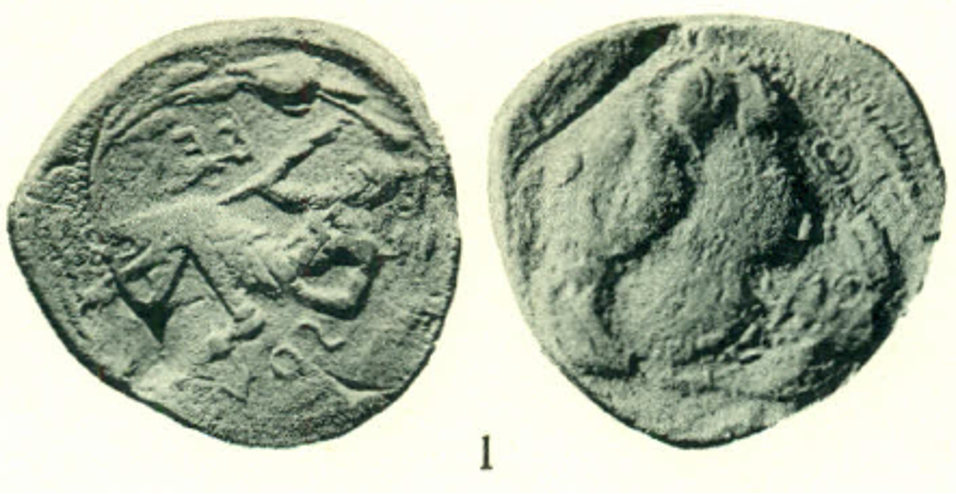1919 - Rhegium (tetradrachm lion/Iocastus) over Athens (Athena/owl) (Munich, Staatliche Münzsammlung - Noe 1957, pl. XII, l): Difference between revisions
From SILVER
No edit summary |
|||
| Line 7: | Line 7: | ||
|Reverse description=Iokastos seating left, holding stick, within oliv wreath. | |Reverse description=Iokastos seating left, holding stick, within oliv wreath. | ||
|Mint=Rhegium | |Mint=Rhegium | ||
|Ancient region= | |Ancient region=Calabria | ||
|Date from=450 BCE | |Date from=450 BCE | ||
|Date to=445 BCE | |Date to=445 BCE | ||
| Line 20: | Line 20: | ||
|Overstruck mint=Athens | |Overstruck mint=Athens | ||
|Overstruck ancient region=Attica | |Overstruck ancient region=Attica | ||
|Overstruck date from=500 BCE | |||
|Overstruck date to=450 BCE | |||
|Overstruck period=Classical | |||
|Overstruck denomination=tetradrachm | |||
|Overstruck standard=Attic | |||
}} | }} | ||
Revision as of 08:22, 18 August 2023
450 BCE - 445 BCE | RECINON
Location/history
| Museum collectionMuseum collection: | München, Staatliche Münzsammlung | |
Overstriking coin
Description
| ObverseInscription or printing placed on the obverse.: | Head of lion facing. Border of dots. | ReverseInscription or printing placed on the reverse.: | RECINON (Greek) Iokastos seating left, holding stick, within oliv wreath. |
Mint and issuing power
| MintIdentifies the place of manufacture or issue of a numismatic object.: | Rhegium | Ancient regionAncient region. | Calabria | Modern countryModern country: Italy | AuthorityIdentifies the issuing power. The authority can be "pretended" when the name or the portrait of X is on the coin but he/she was not the issuing power. It can also be "uncertain" when there is no mention of X on the coin but he/she was the issuing power according to the historical sources: |
Chronology
| FromIdentifies the initial date in a range assigned in a numismatic context. 450 BCE toIdentifies the final date in a range assigned in a numismatic context.. 445 BCE | Classical 480-323 BC |
Physical description
| MetalThe physical material (usually metal) from which an object is made.: Silver |
WeightWeight of the numismatic object (in grams). in grams: 15.9715.97 g <br />15,970 mg <br /> | DenominationTerm indicating the value of a numismatic object. Examples: tetradrachm, chalkous, denarius.: tetradrachm |
|
| StandardStandard.: Attic | |||
References
| Coin referenceReference of the Coin: | Noe 1957, p. 13-42, pl. V-XIV (group VIII, p. 35, pl. XII, l)., Kraay 1969, p. 141-150, pl. XII, n° 4 | Coin series referenceReference to coin series study: | HN Italy1HN Italy, n° 2477., HGC 12HGC 1, n° 1633. |
| Coin series web referenceCoin series web references: | |||
Overstruck type
Description
| ObverseInscription or printing placed on the obverse.: | ReverseInscription or printing placed on the reverse.: |
Mint and issuing power
| MintIdentifies the place of manufacture or issue of a numismatic object. ᵖ: | Athens | Ancient regionAncient region. ᵖ | Attica | Modern countryModern country: Greece | AuthorityIdentifies the authority in whose name (explicitly or implicitly) a numismatic object was issued. ᵖ: |
Chronology
| FromIdentifies the initial date in a range assigned in a numismatic context. 500 BCE toIdentifies the final date in a range assigned in a numismatic context.. 450 BCE | Classical 480-323 BC |
Physical description
| DenominationTerm indicating the value of a numismatic object. Examples: tetradrachm, chalkous, denarius. ᵖ: | tetradrachm |
StandardStandard. ᵖ: | Attic |
References
| Coin type referenceReference to coin series study ᵖ: |
Additional data
| Frequency of overstrikesFrequency of overstrikes: | Level of confidenceLevel of confidence of the identification: | ||
| RemarksRemarks: | |||
